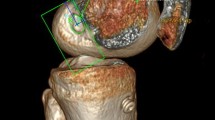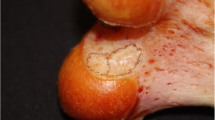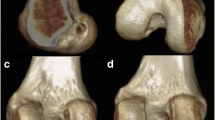Abstract
Purpose
To evaluate the feedback from post-operative three-dimensional computed tomography (3D-CT) on femoral tunnel placement in the learning process, to obtain an anatomic anterior cruciate ligament (ACL) reconstruction.
Methods
A series of 60 consecutive patients undergoing primary ACL reconstruction using autologous hamstrings single-bundle outside-in technique were prospectively included in the study. ACL reconstructions were performed by the same trainee-surgeon during his learning phase of anatomic ACL femoral tunnel placement. A CT scan with dedicated tunnel study was performed in all patients within 48 h after surgery. The data obtained from the CT scan were processed into a three-dimensional surface model, and a true medial view of the lateral femoral condyle was used for the femoral tunnel placement analysis. Two independent examiners analysed the tunnel placements. The centre of femoral tunnel was measured using a quadrant method as described by Bernard and Hertel. The coordinates measured were compared with anatomic coordinates values described in the literature [deep-to-shallow distance (X-axis) 28.5%; high-to-low distance (Y-axis) 35.2%]. Tunnel placement was evaluated in terms of accuracy and precision. After each ACL reconstruction, results were shown to the surgeon to receive an instant feedback in order to achieve accurate correction and improve tunnel placement for the next surgery. Complications and arthroscopic time were also recorded.
Results
Results were divided into three consecutive series (1, 2, 3) of 20 patients each. A trend to placing femoral tunnel slightly shallow in deep-to-shallow distance and slightly high in high-to-low distance was observed in the first and the second series. A progressive improvement in tunnel position was recorded from the first to second series and from the second to the third series. Both accuracy (+52.4%) and precision (+55.7%) increased from the first to the third series (p < 0.001). Arthroscopic time decreased from a mean of 105 min in the first series to 57 min in the third series (p < 0.001). After 50 ACL reconstructions, a satisfactory anatomic femoral tunnel was reached.
Conclusion
Feedback from post-operative 3D-CT is effective in the learning process to improve accuracy and precision of femoral tunnel placement in order to obtain anatomic ACL reconstruction and helps to reduce also arthroscopic time and learning curve. For clinical relevance, trainee-surgeons should use feedback from post-operative 3DCT to learn anatomic ACL femoral tunnel placement and apply it appropriately.
Level of evidence
Consecutive case series, Level IV.







Similar content being viewed by others
References
Abebe ES, Utturkar GM, Taylor DC, Spritzer CE, Kim JP, Moorman CT III, Garrett WE, DeFrate LE (2011) The effects of femoral graft placement on in vivo knee kinematics after anterior cruciate ligament reconstruction. J Biomech 44(5):924–929
Bernard M, Hertel P, Hornung H, Cierpinski T (1997) Femoral insertion of the ACL. Radiographic quadrant method. Am J Knee Surg 10:14–21
Bird JH, Carmont MR, Dhillon M, Smith N, Brown C, Thompson P, Spalding T (2011) Validation of a new technique to determine midbundle femoral tunnel position in anterior cruciate ligament reconstruction using 3-dimensional computed tomography analysis. Arthroscopy 27:1259–1267
Brown CH, Spalding T, Robb C (2013) Medial portal technique for single-bundle anatomical anterior cruciate ligament (ACL) reconstruction. Int Orthop 37:253–269
Carulli C, Matassi F, Soderi S, Sirleo L, Munz G, Innocenti M (2017) Resorbable screw and sheath versus resorbable interference screw and staples for ACL reconstruction: a comparison of two tibial fixation methods. Knee Surg Sports Traumatol Arthrosc 25(4):1264–1271
Collette M, Cassard X (2011) The Tape Locking Screw technique (TLS): a new ACL reconstruction method using a short hamstring graft. Orthop Traumatol Surg Res 97:555–559
Ferretti M, Ekdahl M, Shen W, Fu FH (2007) Osseous landmarks of the femoral attachment of the anterior cruciate ligament: an anatomic study. Arthroscopy 23:1218–1225
Fu FH, van Eck CF, Tashman S, Irrgang JJ, Moreland MS (2015) Anatomic anterior cruciate ligament reconstruction: a changing paradigm. Knee Surg Sports Traumatol Arthrosc 23(3):640–648
Grood ES, Suntay WJ (1983) A joint coordinate system for the clinical description of three dimensional motions: application to the knee. J Biomech Eng 105:136–144
Henckel J, Richards R, Lozhkin K, Harris S, Rodriguez y Baena FM, Barrett AR, Cobb JP (2006) Very low-dose computed tomography for planning and outcome measurement in knee replacement for planning and outcome measurements in knee replacement. The imperial knee protocol. J Bone Joint Surg Br 88:1513–1518
Hohmann E, Bryant A, Tetsworth K (2010) Tunnel positioning in anterior cruciate ligament reconstruction: how long is the learning curve? Knee Surg Sports Traumatol Arthrosc 18:1576–1582
Horie M, Muneta T, Yamazaki J, Nakamura T, Koga H, Watanabe T, Sekiya I (2015) A modified quadrant method for describing the femoral tunnel aperture positions in ACL reconstruction using two-view plain radiographs. Knee Surg Sports Traumatol Arthrosc 23(4):981–985
Inderhaug E, Larsen A, Strand T, Waaler PA, Solheim E (2016) The effect of feedback from post-operative 3D CT on placement of femoral tunnels in single-bundle anatomic ACL reconstruction. Knee Surg Sports Traumatol Arthrosc 24(1):154–160
Iriuchishima T, Ryu K, Suruga M, Aizawa S, Fu FH (2017) The correlation of femoral tunnel length with the height and area of the lateral wall of the femoral intercondylar notch in anatomical single-bundle ACL reconstruction. Knee Surg Sports Traumatol Arthrosc 25(5):1632–1637
Kohn D, Busche T, Carls J (1998) Drill hole position in endoscopic anterior cruciate ligament reconstruction. Results of an advanced arthroscopy course. Knee Surg Sports Traumatol Arthrosc 6(Suppl 1):S13–S15
Luites JW, Wymenga AB, Blankevoort L, Eygendaal D, Verdonschot N (2014) Accuracy of a computer-assisted planning and placement system for anatomical femoral tunnel positioning in anterior cruciate ligament reconstruction. Int J Med Robot 10(4):438–446
Luthringer TA, Blackmore SA, Singh BC, Strauss EJ (2016) The learning curve associated with anteromedial portal drilling in ACL reconstruction. Phys Sportsmed 44(2):141–147
Markolf KL, Hame S, Hunter DM, Oakes DA, Zoric B, Gause P, Finerman GA (2002) Effects of femoral tunnel placement on knee laxity and forces in an anterior cruciate ligament graft. J Orthop Res 20:1016–1024
Matassi F, Sirleo L, Carulli C, Innocenti M (2015) Anatomical anterior cruciate ligament reconstruction: transtibial versus outside-in technique: SIGASCOT Best Paper Award Finalist 2014. Joints 3(1):6–14
Meuffels DE, Reijman M, Verhaar JA (2012) Computer-assisted surgery is not more accurate or precise than conventional arthroscopic ACL reconstruction: a prospective randomized clinical trial. J Bone Joint Surg Am 94(17):1538–1545
Moisala AS, Jarvela T, Harilainen A, Sandelin J, Kannus P, Jarvinen M (2007) The effect of graft placement on the clinical outcome of the anterior cruciate ligament reconstruction a prospective study. Knee Surg Sports Traumatol Arthrosc 15:879–887
Musahl V, Plakseychuk A, VanScyoc A, Sakaki T, Debski RE, McMahon PJ, Fu FH (2005) Varying femoral tunnels between the anatomical footprint and isometric positions: effect on kinematics of the anterior cruciate ligament reconstructed knee. Am J Sports Med 33:712–718
Parkar AP, Adriaensen ME, Fischer-Bredenbeck C, Inderhaug E, Strand T, Assmus J, Solheim E (2015) Measurements of tunnel placements after anterior cruciate ligament reconstruction—a comparison between CT, radiographs and MRI. Knee 22(6):574–579
Parkar AP, Adriaensen ME, Strand T, Inderhaug E, Harlem T, Solheim E (2013) How to read post-operative radiographs and CT scans after single-bundle anterior cruciate ligament reconstruction. Skeletal Radiol 42(11):1489–1500
Piefer JW, Pflugner TR, Hwang MD, Lubowitz JH (2012) Anterior cruciate ligament femoral footprint anatomy: systematic review of the 21st century literature. Arthroscopy 28:872–881
Sadoghi P, Kröpfl A, Jansson V, Müller PE, Pietschmann MF, Fischmeister MF (2011) Impact of tibial and femoral tunnel position on clinical results after anterior cruciate ligament reconstruction. Arthroscopy 27(3):355–364
Sati M, Staubli H, Bourquin Y, Kunz M, Nolte LP (2002) Real-time computerized in situ guidance system for ACL graft placement. Comput Aided Surg 7:25–40
Seo SS, Kim CW, Kim JG, Jin SY (2013) Clinical results comparing transtibial technique and outside in technique in single bundle anterior cruciate ligament reconstruction. Knee Surg Relat Res 25:133–140
Snyder GM, Johnson DL (2011) Anatomic graft placement in ACL surgery: plain radiographs are all we need. Orthopedics 34(2):116–118
Sommer C, Friederich NF, Muller W (2000) Improperly placed anterior cruciate ligament grafts: correlation between radiological parameters and clinical results. Knee Surg Sports Traumatol Arthrosc 8:207–213
Tsukada S, Fujishiro H, Watanabe K, Nimura A, Mochizuki T, Mahakkanukrauh P, Yasuda K, Akita K (2014) Anatomic variations of the lateral intercondylar ridge: relationship to the anterior margin of the anterior cruciate ligament. Am J Sports Med 42(5):1110
Van Eck CF, Martins CAQ, Vyas SM, Celentano U, Van Dijk CN, Fu FH (2010) Femoral intercondylar notch shape and dimensions in ACL-injured patients. Knee Surg Sports Traumatol Arthrosc 18:1257–1262
Wilson AJ, Yasen SK, Nancoo T, Stannard R, Smith JO, Logan JS (2013) Anatomic all-inside anterior cruciate ligament reconstruction using the translateral technique. Arthrosc Tech 2(2):e99–e104
Wu G, Siegler S, Allard P, Kirtley C, Leardini A, Rosenbaum D, Whittle M, D’Lima DD, Cristofolini L, Witte H, Schmid O, Stokes I, Standardization and Terminology Committee of International Society of Biomechanics (2002) ISB recommendation on definitions of joint coordinate systems of various joints for the reporting of human joint motion—part I: ankle, hip, and spine. J Biomech 35(4):543–548
Youm Y-S, Cho S-D, Eo J, Lee K-J, Jung K-H, Cha J-R (2013) 3D CT analysis of femoral and tibial tunnel positions after modified transtibial single bundle ACL reconstruction with varus and internal rotation of the tibia. Knee 20:272–276
Zavras TD, Race A, Amis AA (2005) The effect of femoral attachment location on anterior cruciate ligament reconstruction: graft tension patterns and restoration of normal anterior-posterior laxity patterns. Knee Surg Sports Traumatol Arthrosc 13:92–100
Author information
Authors and Affiliations
Corresponding author
Ethics declarations
Conflict of interest
The authors declare that they have no conflict of interest.
Funding
No funding sources were received for this study.
Ethical approval
The study and follow-up, respecting the criteria of the Declaration of Helsinki, has been approved by Institutional Review Board of Azienda Ospedaliera-Universitaria Careggi—Department of Surgery and Translational Medicine. The IRB number was DCMT2012/DIC/STUDI.SPER/2012.009.ORT.
Informed consent
All patients accepted the proposed treatment and follow-up after an adequate information and written consent.
Rights and permissions
About this article
Cite this article
Sirleo, L., Innocenti, M., Innocenti, M. et al. Post-operative 3D CT feedback improves accuracy and precision in the learning curve of anatomic ACL femoral tunnel placement. Knee Surg Sports Traumatol Arthrosc 26, 468–477 (2018). https://doi.org/10.1007/s00167-017-4614-7
Received:
Accepted:
Published:
Issue Date:
DOI: https://doi.org/10.1007/s00167-017-4614-7




